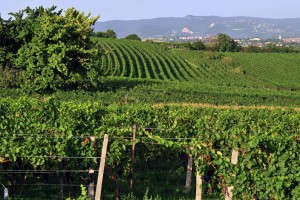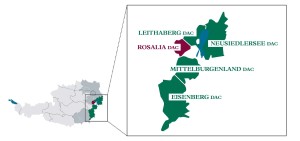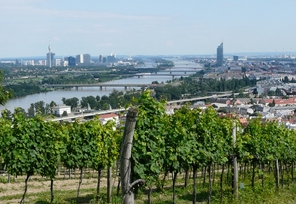The Austrian Wine Marketing Board has announced the approval and registration of a new wine region to be known as the Rosalia Districtus Austriae Controllatus (DAC). The area of Rosalia was previously classified as a Grosslage (large collective vineyard site) and is located in Burgenland, south of the Leithaberg area.
Rosalia is named for the Rosaliengebirge—the Rosalia Mountain Range—that comprises a portion of the Alpine Foothills located on the border between Burgenland and Lower Austria. The Rosalia area is situated on the eastern slopes of the Rosalia mountains and includes the valley of the Wulka River, the political district of Mattersburg, and the famous Forchtenstein Castle. Vineyards are situated in the rolling hills at elevations up to 2,640 feet (750 m).
Three styles of wine are approved under the Rosalia DAC:
- Rosalia DAC: Approved for dry, red, wines based on Blaufränkisch or Zweigelt grapes. These wines are required to contain a minimum of 12% abv and a maximum of 0.4% residual sugar. The wines may be oak-aged, but oak contact is not required. The flavor profile should be “complex, aromatic, and show finesse, fruit, and spiciness.”
- Rosalia Reserve DAC: This designation is also approved for dry, red, wines produced using either Blaufränkisch or Zweigelt; however, Reserve DAC wines require a minimum alcohol content of 13% abv. Rosalia Reserva DAC wines are allowed to list a single-vineyard (Ried) designation on the label.
- Rosalia DAC Rosé: This designation is approved for dry, rosé wines using one or more “quality” grape varieties (as approved for Qualitätswein in Austria). Rosalia DAC Rosé must contain less than 0.4% residual sugar and may list a specific vineyard (Ried) on the label; however, a specific grape variety (or varieties) is NOT allowed to be stated on the label. The wine is intended to be aromatic with the scent of red berries and show “fresh, fruity, and spicy” flavors.
Rosalia is the 11th area in Austria to be recognized as a DAC wine production region. We can expect to see the Rosalia DAC designation on bottles and labels with the release of wines from the 2017 vintage. Welcome to the world, Rosalia DAC!
References/for more information:
- https://www.austrianwine.com/press-multimedia/news/news/article/rosalia-a-grosslage-becomes-a-dac-region-1/
- http://www.vinum-rosalia.at/
- http://www.weinburgenland.at/en/our-wine/specific-wine-growing-areas/rosalia/
- https://www.austrianwine.com/our-wine/grape-varieties/
- Rosalia DAC Regulations (in German)
Are you interested in being a guest blogger or a guest SWEbinar presenter for SWE? Click here for more information!
Post authored by Jane A. Nickles—your blog administrator: jnickles@societyofwineeducators.org




